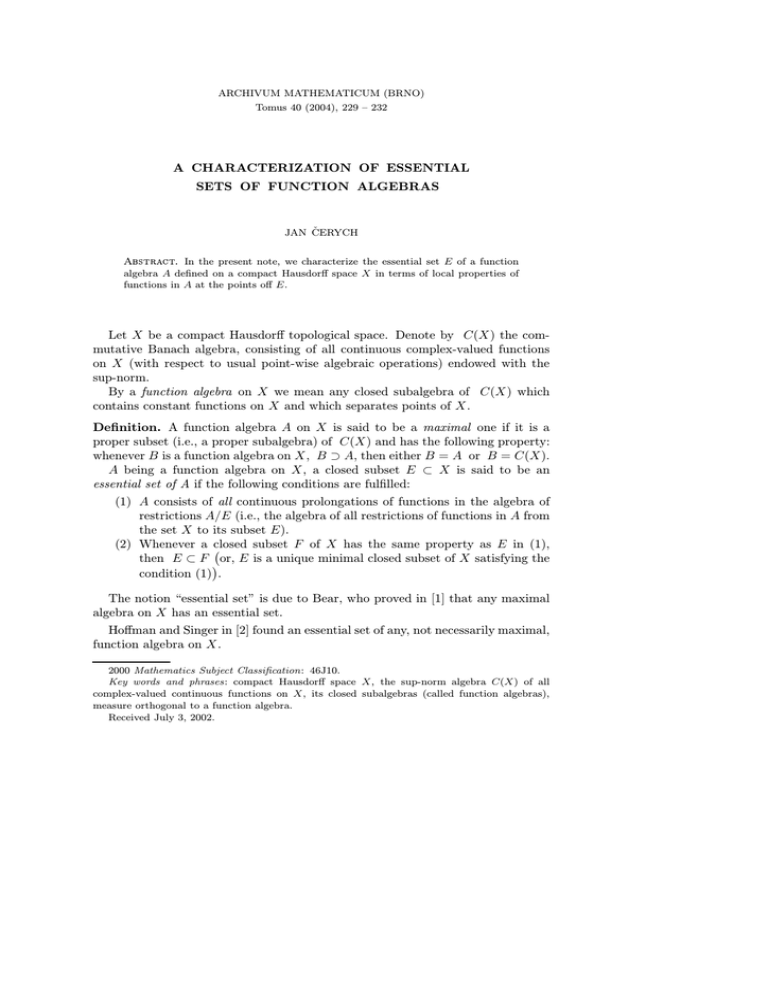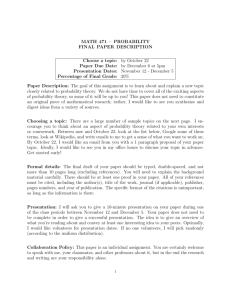Document 10514204
advertisement

ARCHIVUM MATHEMATICUM (BRNO)
Tomus 40 (2004), 229 – 232
A CHARACTERIZATION OF ESSENTIAL
SETS OF FUNCTION ALGEBRAS
JAN ČERYCH
In the present note, we characterize the essential set E of a function
algebra A defined on a compact Hausdorff space X in terms of local properties of
functions in A at the points off E.
Let X be a compact Hausdorff topological space. Denote by C(X) the commutative Banach algebra, consisting of all continuous complex-valued functions
on X (with respect to usual point-wise algebraic operations) endowed with the
sup-norm.
By a function algebra on X we mean any closed subalgebra of C(X) which
contains constant functions on X and which separates points of X.
Definition. A function algebra A on X is said to be a maximal one if it is a
proper subset (i.e., a proper subalgebra) of C(X) and has the following property:
whenever B is a function algebra on X, B ⊃ A, then either B = A or B = C(X).
A being a function algebra on X, a closed subset E ⊂ X is said to be an
essential set of A if the following conditions are fulfilled:
(1) A consists of all continuous prolongations of functions in the algebra of
restrictions A/E (i.e., the algebra of all restrictions of functions in A from
the set X to its subset E).
(2) Whenever a closed subset F of X has the same property as E in (1),
then E ⊂ F or, E is a unique minimal closed subset of X satisfying the
condition (1) .
The notion “essential set” is due to Bear, who proved in [1] that any maximal
algebra on X has an essential set.
Hoffman and Singer in [2] found an essential set of any, not necessarily maximal,
function algebra on X.
2000 Mathematics Subject Classification: 46J10.
Key words and phrases: compact Hausdorff space X, the sup-norm algebra C(X) of all
complex-valued continuous functions on X, its closed subalgebras (called function algebras),
measure orthogonal to a function algebra.
Received July 3, 2002.
230
J. ČERYCH
Denote by M (X) the space of all complex Borel regular measures on X, i.e.,
by the Riesz Representation Theorem, the dual space of C(X).
The annihilator A⊥ of a function
algebra A is defined to be the set of all
R
measures m ∈ M (X) such that f dm = 0 for any f ∈ A, or the set of all
measures orthogonal to A. The dual space A0 of A is then canonically isomorphic
to the quotient space M (X)/A⊥ .
Now endow M (X) with the weak-star topology: it is well known that M (X)
becomes a locally convex topological linear space with the dual space C(X).
Definition. Let A be a function algebra on X. A (closed nonvoid) set F ⊂ X
is said to be a peak set (of A) if there exists a function f ∈ A with the following
properties:
(1) f (x) = 1 for any x ∈ F ;
(2) |f (y)| < 1 for any y ∈ X r F .
In this case we say that f peaks on F .
In [3], we have proved the following
Theorem 1. Let A be a function algebra on X. Denote by E the closure of the
union of all closed supports of measures in A⊥ . Then E is the essential set of A.
Our aim here is to characterize the essential set E of a function algebra A in
terms of local properties of functions in A at the points off E. More precisely, we
shall prove the following
Theorem 2. Let A be a function algebra on X. Denote by E its essential set.
Let x ∈ X. Then x ∈ X r E if and only if there exists a closed neigbourhood V
of x in X such that the following two conditions are fulfilled:
(3) A/V = C(V ), where A/V means the algebra of all restrictions of functions
from A to the set V ;
(4) V is an intersection of peak sets of A.
Proof. Let at first x ∈ X r E.
Take as V such an closed neighbourhood which does not meet E.
Condition (3) follows immediately from the definition of the essential set.
For any y ∈ X r(E ∪V ) let fy0 be a function defined on the set Hy = E ∪{y}∪V
such that it is equal to 1 on V and to 0 on E ∪ {y}. We can, by the classical Tietze
Theorem, construct a function f˜y ∈ C(X) which is equal to fy0 on the set Hy .
Finally, put fy = min(1, f˜y ). Then fy ∈ C(X) and f is equal to 0 on E; it follows
from the definition of the essential set that fy ∈ A.
Denote the set on which fy peaks by Fy . Then Fy ⊃ V and Fy does not meet
E ∪ {y}. It follows that
\
V =
Fy ,
y∈Xr(E∪V )
the condition (4).
A CHARACTERIZATION OF ESSENTIAL SETS OF FUNCTION ALGEBRAS
231
Let, on the contrary, be V such closed neighborhood of x that the conditions
(3), (4) are fulfilled. Let m is a measure on X such that spt m, its closed support,
has nonvoid intersection with int V , the interior of V . We shall prove that m is
not in A⊥ ; it will follow from Theorem 1 that x ∈
/ E.
Let f ∈ C(V ) be such that
(5)
Z
sptf ⊂ int V ,
f dm 6= 0 .
V
It follows from (3) that there exists a function g ∈ A such that g/V = f . It is
f = g = 0 on the boundary of V and then the the sets
(6)
Un ≡ V ∪ {y ∈ X; |g(y)| <
1
, n = 1, 2, . . . }
n
containing V are open.
The set X r Un is a compact one; the system S of all peak sets of A containing
V is a system of compact sets whose intersection is V by (4). It follows that there
is a finite subsystem F1 , F2 , . . . , Fk of S such that
(7)
Vn ≡
k
\
Fj ⊂ U n .
j=1
But the (nonvoid) intersection of peak sets is a peak set: if fj peaks on Fj , then
Q
fj peaks on ∩Fj . We have proved: there exists a sequence Vn , n = 1, 2, . . . of
peak sets of A such that
(8)
V ⊂ V n ⊂ Un ,
n = 1, 2, . . .
It is easy to see that the intersection W ≡
peaks on Vn , then the function
h≡
∞
X
T∞
n=1
Vn is a peak set of A: if hn ∈ A
2−n hn
n=1
peaks on W . It follows from (7) and (8) that
(9)
V ⊂ W ⊂ V ∪ {y ∈ X; g(y) = 0} .
We have
hn (y) = 1 for y ∈ W ,
hn (y) → 0 for n → ∞, y ∈ X r V .
It follows from (9) that
(g · hn )(y) = g(y) ≤ f (y) for y ∈ V ,
(g · hn )(y) → 0 for n → ∞, y ∈ X r W .
232
J. ČERYCH
Since |g · hn | = |g| · |h|n = |g|, we have by the Lebesgue Dominated Convergence
Theorem and by (9) and (5)
Z
g · hn dm →
Z
g dm =
W
Z
g dm =
V
Z
f dm 6= 0 .
V
But g · hn ∈ A for n = 1, 2, . . . and then the measure m is not in A⊥ .
At first look at Theorem 1 and 2 it would appear that the condition (4) in
Theorem 2 is superfluous and could be omitted. The next example shows that it
is not the case.
Example. Let A be the classical disk algebra, i.e. the algebra of all functions
continuous on the closed unit disk K in the complex plane which are holomorphic
on the interior of K.
Let B be the restriction of A to the set
F ≡ {z ∈ K; |z| = 1 or z = 0} .
Zero is an isolated point of F ; it follows that B/{0} = C({0}).
Let µ be such a measure on F that for any f ∈ C(F )
Z
f dµ =
1
2πi
Z
f (z) dz
− f (0) .
z
|z|=1
Then µ ∈ B ⊥ by Cauchy Formula. There is |µ|(0) = 1, so 0 is in the essential set
of B, by Theorem 1.
References
[1] Bear, H. S., Complex function algebras, Trans. Amer. Math. Soc. 90 (1959), 383–393.
[2] Hoffman, K., Singer, I. M., Maximal algebras of continuous functions, Acta Math. 103
(1960), 217–241.
[3] Čerych, J., On essential sets of function algebras in terms of their orthogonal measures,
Comment. Math. Univ. Carolin. 36, 3 (1995), 471–474.
! "# $ % &$&')(!*,+(!-/.!.0 1( 2 #3 546



